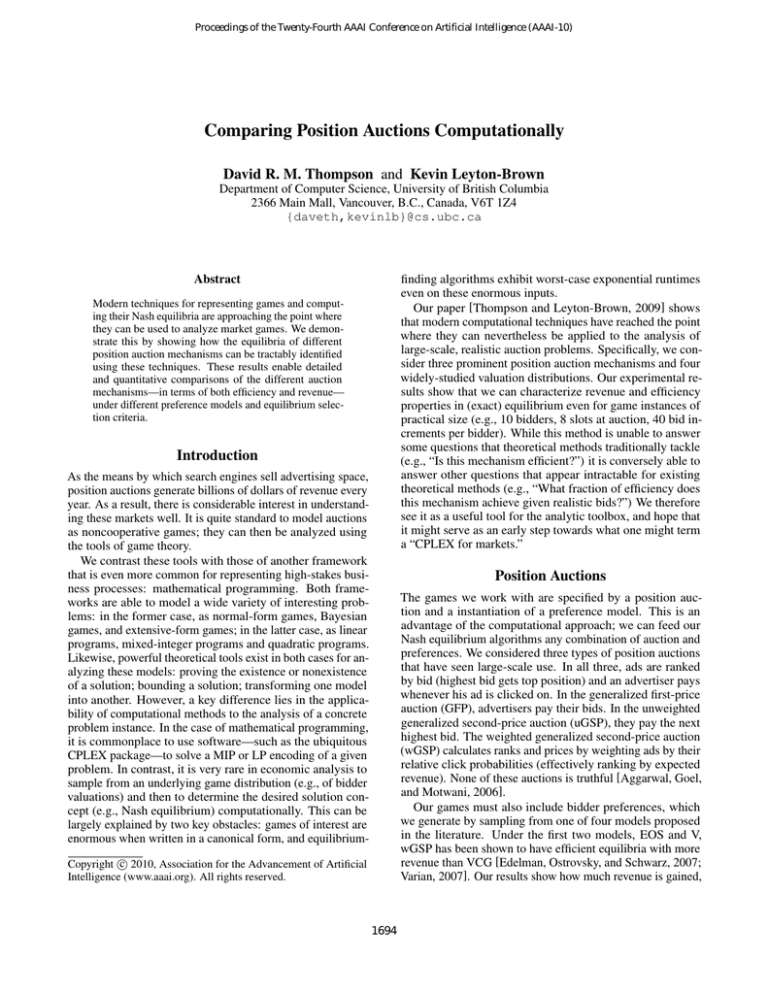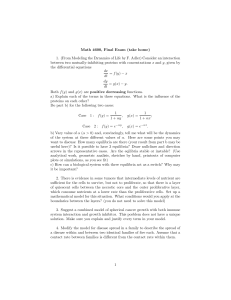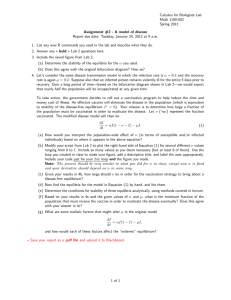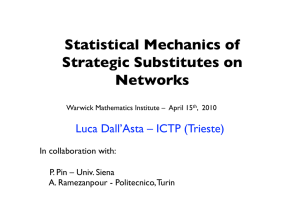
Proceedings of the Twenty-Fourth AAAI Conference on Artificial Intelligence (AAAI-10)
Comparing Position Auctions Computationally
David R. M. Thompson and Kevin Leyton-Brown
Department of Computer Science, University of British Columbia
2366 Main Mall, Vancouver, B.C., Canada, V6T 1Z4
{daveth,kevinlb}@cs.ubc.ca
Abstract
finding algorithms exhibit worst-case exponential runtimes
even on these enormous inputs.
Our paper [Thompson and Leyton-Brown, 2009] shows
that modern computational techniques have reached the point
where they can nevertheless be applied to the analysis of
large-scale, realistic auction problems. Specifically, we consider three prominent position auction mechanisms and four
widely-studied valuation distributions. Our experimental results show that we can characterize revenue and efficiency
properties in (exact) equilibrium even for game instances of
practical size (e.g., 10 bidders, 8 slots at auction, 40 bid increments per bidder). While this method is unable to answer
some questions that theoretical methods traditionally tackle
(e.g., “Is this mechanism efficient?”) it is conversely able to
answer other questions that appear intractable for existing
theoretical methods (e.g., “What fraction of efficiency does
this mechanism achieve given realistic bids?”) We therefore
see it as a useful tool for the analytic toolbox, and hope that
it might serve as an early step towards what one might term
a “CPLEX for markets.”
Modern techniques for representing games and computing their Nash equilibria are approaching the point where
they can be used to analyze market games. We demonstrate this by showing how the equilibria of different
position auction mechanisms can be tractably identified
using these techniques. These results enable detailed
and quantitative comparisons of the different auction
mechanisms—in terms of both efficiency and revenue—
under different preference models and equilibrium selection criteria.
Introduction
As the means by which search engines sell advertising space,
position auctions generate billions of dollars of revenue every
year. As a result, there is considerable interest in understanding these markets well. It is quite standard to model auctions
as noncooperative games; they can then be analyzed using
the tools of game theory.
We contrast these tools with those of another framework
that is even more common for representing high-stakes business processes: mathematical programming. Both frameworks are able to model a wide variety of interesting problems: in the former case, as normal-form games, Bayesian
games, and extensive-form games; in the latter case, as linear
programs, mixed-integer programs and quadratic programs.
Likewise, powerful theoretical tools exist in both cases for analyzing these models: proving the existence or nonexistence
of a solution; bounding a solution; transforming one model
into another. However, a key difference lies in the applicability of computational methods to the analysis of a concrete
problem instance. In the case of mathematical programming,
it is commonplace to use software—such as the ubiquitous
CPLEX package—to solve a MIP or LP encoding of a given
problem. In contrast, it is very rare in economic analysis to
sample from an underlying game distribution (e.g., of bidder
valuations) and then to determine the desired solution concept (e.g., Nash equilibrium) computationally. This can be
largely explained by two key obstacles: games of interest are
enormous when written in a canonical form, and equilibrium-
Position Auctions
The games we work with are specified by a position auction and a instantiation of a preference model. This is an
advantage of the computational approach; we can feed our
Nash equilibrium algorithms any combination of auction and
preferences. We considered three types of position auctions
that have seen large-scale use. In all three, ads are ranked
by bid (highest bid gets top position) and an advertiser pays
whenever his ad is clicked on. In the generalized first-price
auction (GFP), advertisers pay their bids. In the unweighted
generalized second-price auction (uGSP), they pay the next
highest bid. The weighted generalized second-price auction
(wGSP) calculates ranks and prices by weighting ads by their
relative click probabilities (effectively ranking by expected
revenue). None of these auctions is truthful [Aggarwal, Goel,
and Motwani, 2006].
Our games must also include bidder preferences, which
we generate by sampling from one of four models proposed
in the literature. Under the first two models, EOS and V,
wGSP has been shown to have efficient equilibria with more
revenue than VCG [Edelman, Ostrovsky, and Schwarz, 2007;
Varian, 2007]. Our results show how much revenue is gained,
c 2010, Association for the Advancement of Artificial
Copyright Intelligence (www.aaai.org). All rights reserved.
1694
as well as showing the existence of other equilibria. Under
the other models, BHN and BSS, wGSP has been shown to
sometimes have no efficient equilibrium [Benisch, Sadeh,
and Sandholm, 2008; Blumrosen, Hartline, and Nong, 2008].
Our results quantify the magnitude and frequency of these
efficiency losses. We also show how wGSP compares with
uGSP and GFP in each model.
Representation
Consider again the example of mathematical programming.
Large problems can have millions of constraints and variables; any non-sparse representation of the constraint matrix
would be prohibitively large. Similarly, if we were to represent our largest position-auction games (with 10 players and
41 actions per player) in the normal form, each one would
require over 900,000 terabytes! In order to be able to reason
about realistic problems in practice, compact representations
are crucial.
Action graph games (AGGs, [Jiang and Leyton-Brown,
2006]) are the critical technology that makes it possible for
us to compactly represent our auction games. For example,
the game just described has an AGG representation of only
tens of megabytes. AGGs are like Bayes nets: they use independence to reduce large tables into smaller factors, whose
relationships are represented by a directed graph. AGGs focus on context-specific independence, allowing an agent’s
choice of action to determine the variables upon which his
payoff depends. In an action graph, every node corresponds
to an action that one or more players can play. An arc from
node a to node b implies that the payoff of any agent playing
action b depends on how many agents played action a. When
every action node has bounded in-degree the representation
size of an AGG scales polynomially, and is exponentially
smaller than the equivalent normal-form game.
Representing position auctions as AGGs is not trivial. A
naive AGG representation could be nearly as big as the normal form: any bid can affect the price for a higher bidder
or the position of a lower bidder, meaning the action graph
would have to be almost fully connected. However, since
each bidder’s payoff is determined only by his position and
price, we can use “function nodes” to calculate those values.
Function nodes are special nodes in the action graph that
do not correspond to any action. The value of a function
node (used in computing the payoffs of playing neighboring actions) is determined by a function on the values of its
neighbors. These functions can be understood as sufficient
statistics over action counts. For example, a summation function node can be used to count the number of players playing
a set of actions that all have the same cumulative effect on
the other players. This can be used to reduce the in-degree of
the action nodes, and therefore the representation size.
To calculate the position a bidder will obtain in an auction,
we need only to count how many bids are greater than his
and how many are equal. (Because bids are discrete, we
must consider ties.) This can easily be done using summation
function nodes (see Figure 1). In the case of a GFP, this
is sufficient to compute an agent’s payoff because his price
will be determined by his own bid. In the case of a GSP, we
Figure 1: To compute the position a bid will win, we need to
know how many bids were equal and how many were greater.
This is calculated using summation nodes (squares).
Figure 2: To compute a price, we must know the next highest
bid. This is calculated using an argmax node (hexagon), for
each bid. (Only one is shown for readability.)
also need function nodes to compute the price an agent will
have to pay. We use an “argmax” function node, connected
to every lower bid (see Figure 2). The argmax node’s value
is equal to the highest index of an edge with a non-zero
value. This value identifies the next highest bidder and his
bid, which is sufficient to compute a price.
We simplify the game by selectively removing weaklydominated strategies: those in which agents bid above their
own values. In general, removing weakly-dominated strategies can eliminate some Nash equilibria. However, in this
case, the only equilibria that are removed are (1) those that
lead to the same outcome as some equilibrium that was not
removed, or (2) those that lead to some outcome that is
1695
only reachable when at least one agent plays the weaklydominated strategy of bidding higher than his own value.
Computing Nash Equilibria
Many families of mathematical programs are theoretically
intractable, but routinely solved in practice by algorithms that
achieve good empirical performance on realistic instances.
To analyze position auctions computationally, we similarly
need algorithms that perform well empirically. There has
been recent research into the performance of algorithms on
different game distributions [Nudelman et al., 2004; Porter,
Nudelman, and Shoham, 2004]. Two of the most powerful
algorithms are simpdiv [Scarf, 1967] and gnm [Govindan
and Wilson, 2005]. Crucially, these have been adapted to
work with AGGs [Jiang and Leyton-Brown, 2006]; as a result,
their worst-case performance is exponential in the size of the
AGG rather than the size of the normal form. We made a
small change to both algorithms, imposing a simple static
restart strategy (restarting every 5 minutes). This gained us a
substantial overall speedup: for many instances, the fastest
run took a few seconds while the slowest runs timed out.
One problem with both of these algorithms is that they return arbitrary Nash equilibria. In position auctions, there can
be many Nash equilibria that lead to substantially different
outcomes. For example, in a GSP, the bidder with the ith
highest value can choose any value between the (i − 1)th bid
and the (i + 1)th bid, and the only effect will be to change the
price for the (i − 1)th highest bidder. There can be whole sets
of Nash equilibria differing only in such bids, each yielding
different revenue. To address this problem, while exploiting the fact that equilibria appear in connected regions of
strategy space, we apply local search. Starting from each
Nash equilibrium, we use a randomized hill-climbing algorithm to search through strategy space for equilibria with
maximal/minimal revenue/social-welfare (four searches with
different objectives). Considering all of these equilibria, we
get a clearer picture of the range of equilibrium outcomes.
Figure 3: Average efficiency of the worst equilibria (solid
bars) and best equilibria (outline bars). Equilibrium selection
had little effect. wGSP is consistently best.
Results
Figure 4: Revenue of wGSP relative to VCG in best and
worst equilibria (for ESO preferences). In the best equilibria,
wGSP does slightly worse than VCG on average. In the
worst equilibria, wGSP does substantially worse. For V
preferences, wGSP behaves similarly with slightly better
best-case revenue.
One of the benefits of a computational analysis is that it
allows us to make apples-to-apples comparisons between
different auctions given the same bidder preferences. For
example, we found that wGSP was the most efficient of the
three position auctions, even in settings where it was known
to be inefficient (see Figure 3). We also found that efficiency
was relatively unaffected by equilibrium selection. (That
is, the efficiency of wGSP in the EOS and V settings was
not merely a property of envy-free equilibria; instead, all
equilibria were very close to efficient.)
We also compared auctions in terms of revenue; here, the
differences were less consistent. Theoretical results show
that (with continuous values, and with bidders allowed to
bid above their own values) wGSP has Nash equilibria with
strictly more revenue than VCG, in the EOS and V models. The best equilibria we found did not consistently or
substantially yield greater revenue than VCG, and the worst
equilibria achieved substantially less revenue (see Figure 4).
We also found that wGSP did not clearly outperform the other
position auctions; within a single preference distribution, the
relative revenue could vary greatly from one instance to the
next (see Figure 5). In short, we could not conclude that
wGSP was a clear winner in terms of revenue; its revenue
appeared to be very sensitive to equilibrium selection and
details of the problem instance.
Discussion and Conclusions
Overall, we have demonstrated that it is now possible to
compute the exact Nash equilibria of large position auction
games, and to use those equilibria to provide quantitative an-
1696
was effective at exploring regions of connected equilibria,
it is not guaranteed to identify the globally-optimal Nash
equilibrium. Other game-solving algorithms could help with
this, such as the support enumeration method for finding all
Nash equilibria [Porter, Nudelman, and Shoham, 2004], or
algorithms for finding optimal correlated equilibria [Papadimitriou, 2005].
Acknowledgments
This work was supported by a grant under Microsoft’s “Beyond Search” program.
References
Aggarwal, G.; Goel, A.; and Motwani, R. 2006. Truthful
auctions for pricing search keywords. In EC: Proceedings
of the ACM Conference on Electronic Commerce, 1–7. New
York, NY, USA: ACM.
Benisch, M.; Sadeh, N.; and Sandholm, T. 2008. The cost
of inexpressiveness in advertisement auctions. ACM EC
Workshop on Advertisement Auctions.
Blumrosen, L.; Hartline, J.; and Nong, S. 2008. Position auctions and non-uniform conversion rates. ACM EC Workshop
on Advertisement Auctions.
Edelman, B.; Ostrovsky, M.; and Schwarz, M. 2007. Internet
advertising and the generalized second price auction: Selling
billions of dollars worth of keywords. American Economic
Review 97(1):242–259.
Govindan, S., and Wilson, R. 2005. Essential equilibria. Proceedings of the National Academy of Sciences USA
102:15706–15711.
Jiang, A. X., and Leyton-Brown, K. 2006. A polynomialtime algorithm for Action-Graph Games. In Proceedings of
the AAAI Conference on Artificial Intelligence, 679–684.
Nudelman, E.; Wortman, J.; Shoham, Y.; and Leyton-Brown,
K. 2004. Run the GAMUT: A comprehensive approach to
evaluating game-theoretic algorithms. In AAMAS: Proceedings of the International Joint Conference on Autonomous
Agents and Multiagent Systems, 880–887.
Papadimitriou, C. H. 2005. Computing correlated equilibria
in multi-player games. In STOC ’05: Proceedings of the
thirty-seventh annual ACM symposium on Theory of computing, 49–56. New York, NY, USA: ACM.
Porter, R.; Nudelman, E.; and Shoham, Y. 2004. Simple
search methods for finding a Nash equilibrium. In Proceedings of the AAAI Conference on Artificial Intelligence, 664–
669.
Scarf, H. 1967. The approximation of fixed points of continuous mappings. SIAM Journal of Applied Mathematics
15:1328–1343.
Thompson, D. R. M., and Leyton-Brown, K. 2009. Computational analysis of perfect-information position auctions.
In EC: Proceedings of the ACM Conference on Electronic
Commerce, 51–60.
Varian, H. 2007. Position auctions. International Journal of
Industrial Organization 25(6):1163–1178.
Figure 5: Per-instance (from distribution V) revenue of wGSP
versus uGSP (in the best equilibrium). There is no clear
winner.
swers to previously-open questions from the literature. This
advance depended substantially on the recent development
of action graph game, which greatly expanded the set of
games that can be represented in a computationally-useful,
polynomially-scaling form. We found that the widely-used
weighted GSP auction was consistently the most efficient
position auction, but that its revenue performance was highly
sensitive to equilibrium selection and bidder preferences.
Our computational approach to studying position auctions
offers several important advantages over standard methods
of theoretical analysis. We can easily relax the common
assumptions about value distribution (e.g. uniform value-perclick in every slot) and equilibrium concept (e.g. locally envyfree, pure strategy). It is also straightforward to manipulate
auction parameters like reserve prices or rounding behavior.
Finally, we can address quantitative questions, like “how
much social welfare is lost in the worst equilibrium?” or
“which auction generates the most expected revenue?”
Our approach also has several limitations. Chiefly, a computational approach is necessarily tied to the investigation
of specific value distributions. Also, our games are discrete
with relatively few bid increments, which makes issues of
rounding and tie breaking extremely important. This can be
viewed either as a drawback or as a benefit: in fact, tie breaking is important in position auctions, which are typically run
with $0.01 bid increments and clear with prices less than
$0.50. Other limitations offer opportunities for future work.
We are currently restricted to studying full-information, oneshot games. Although it has been argued in the economic
literature that this model is the most appropriate for position
auctions (e.g. [Edelman, Ostrovsky, and Schwarz, 2007]), it
could also be valuable to compute Bayes-Nash equilibria of
imperfect-information position auction games. Progress on
this front will depend on the development of computationallymotivated compact representations that can represent large
Bayesian games. Finally, while our local search algorithm
1697









